Next Gen's STEAM Studio: An After-School STEM Program With a Dab of Creativity
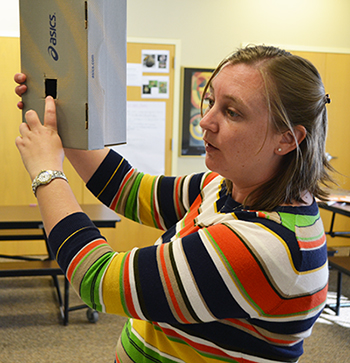
Angela Nelson demonstrates to STEAM studio students how to build sling psycrometer.
October 20, 2014
Most folks have now heard of STEM by now, right? It stands for Science, Technology, Engineering, and Math. Well, Next Generation School (Next Gen) has come up with a new after-school program—and its accompanying revision of the STEM acronym—STEAM. What does the "A"stand for? According to Angela Nelson, the program's director, while the main thrust of the program is still STEM, they've included an additional component: Art.
How do they incorporate art? Here's an example. Last month, while studying ornithology, the students did paintings. But while a painting of a bird might sound quite ordinary, these were not. Each student chose a local bird they wanted to concentrate on, did research to find out what the bird eats, then they got big pieces of paper and white paint and let it fly (or drop, rather), to create…"bird-poop" paintings!
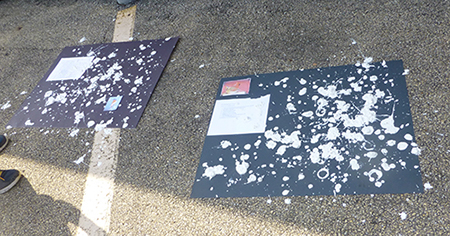
An image of some of the students' recent "bird-poop" paintings (image courtesy of Angela Nelson).
For this fall's inaugural run of STEAM Studio, 22 K–5th graders are participating. However, it isn't just Next Gen students who get to experience this innovative program; of the 22 participants, only two go to Next Gen; all the other youngsters are from other local schools. Students are divided into two age groups, with 6 students in Terra (the group for 3rd–5th graders) and 16 in Zepto (the younger group for K–2nd graders).

A Zepto group student gathers some rocks for testing.
Though students start arriving after school (anywhere from 2:30 pm on), the main lesson, which is instruction-based learning, is from 4:00–5:00 pm. From 5:00–5:45 pm is studio inquiry, during which, according to Nelson, "They have a topic that they're trying to solve, or a problem they're working with, or an invention that they're trying to make."
Nelson says most kids stay until around 5:00 pm or later, when Mom or Dad swings by after work to pick them up; around half of the kids are picked up between 5:00–5:30; the rest between 5:30–5:45.
Do the disparate lengths of times students are available for Studio Inquiry hinder the kids from learning, or pose a problem for the teachers? Nelson says not, because the studio component related to each topic continues for a week or two.
Lessons address a main theme for about 6–8 weeks, with the two age groups looking at different STEM-related subject matter. For example, Terra Group first studied ornithology; now they're doing extreme weather. Their goal for this unit is to produce a news broadcast about a severe storm for a city anywhere in the world. To prepare the students, Nelson is teaching the different aspects of weather, with hands-on activities underscoring the topic. For instance, to learn about relative humidity, students made sling psycrometers, which they then used to measure the relative humidity both inside and outside.
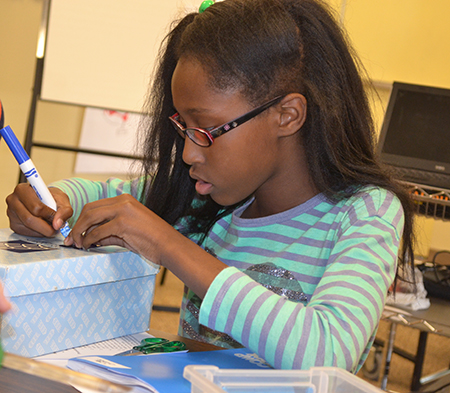
A STEAM participant works on her sling psycrometer.
Zepto Group (the younger students) first studied entomology, which included a field trip to experience some insects up close and personal, then moved on to study about caves, such as how ice caves form, and what talus caves are made of (fallen boulders).
Any chance they'll take the students spelunking? Probably not, since there are few caves in central Illinois. Nelson indicates that students will visit a rock climbing location to learn how to get into and out of caves and to see how the equipment works.
Nelson explains their philosophy regarding field trips: "They key is, when we go to these places, it's not a normal field trip where we just kind of look or do the regular program; we're really looking to talk to guest experts that can answer specific questions about our topic."
In the case of caves, some of the questions will be: "So how can this equipment be used? What are some of the problems with it? Then we'll take that information back and see if we can come up with new strategies to fix things or make our own, or see how it would be applied to a situation."
It appears the Xeptos will undertake a quite ambitious project; building their own cave. But first they have to learn about all the different kinds. Nelson says are twelve: including the one this reporter thinks of, having spent many an afternoon as a child traipsing through the Illinois Caverns, which was about a mile from where I grew up: the limestone sedimentary cave.
"It's not just play time," she says of the cave-building hands-on activity. "It's got a purpose to what we're doing."
Having moved recently, Nelson purposely hung on to the big moving boxes, which they used to build the cave. Then, after studying a variety of speleothem, or cave formations, they constructed replicas of a number of them. For example, they'll make stalactites and stalagmites of crumpled poster paper, then cover them with paper mâché or clay.
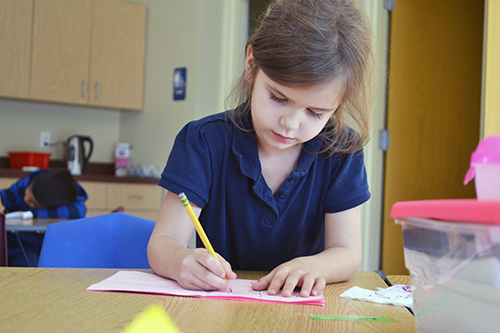
A STEAM participant in the Zepto group adds an entry about talus caves to her cave dictionary.
Also, each student wrote descriptions and/or drew pictures of all the different types of caves to include in a sort of dictionary.
How do the teachers compensate for the difference in abilities based on age for, say, 2nd graders (who can write) vs. kindergarteners (who can't)? Nelson says having students of different ages in the groups is actually a strength, since it provides a mentoring aspect.
"It's a really good opportunity, actually, because it's allowing the second graders to take on more of a leadership role,"says Nelson, "and it's allowing a kindergarten student to gain from seeing what a 2nd grader can do."
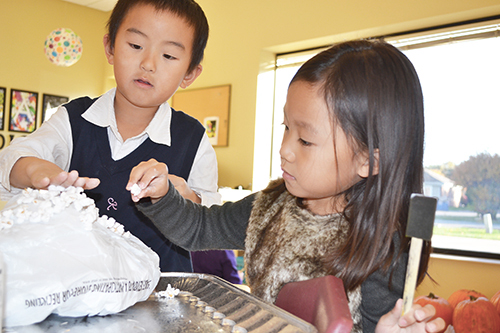
Two STEAM participants in the Zepto group use real popcorn create a replica of a speleothem called cave popcorn.
Nelson describes another positive aspect of mixed-age groups: each child, no matter the age, makes their own unique contribution. "A lot of this is about your creativity, and your imagination, and your ideas that you can bring to the table; so we spend a lot of time talking about how to communicate, how to share your ideas, how to have proof for what you're saying, how to use equipment appropriately, and all those pieces. So all of them are gaining from it."
 STEAM students in the Zepto group create a replica of a pool spar out of clay, marshmallows, and toothpicks.
STEAM students in the Zepto group create a replica of a pool spar out of clay, marshmallows, and toothpicks. In addition to theme-related projects, each group has a citizen science project for the year. Terra group is doing CUB (Celebrate Urban Birds), a Cornell University project whose goal is to teach people about birds in a given area and the importance of parks. Every two weeks students go out and collect data on two locations: the school parking lot and Noel Park. Scientists then use these data for research. The students all have different jobs, including a liaison with the university, who asks, "Ok, this is what we're planning to do; does it make sense? Will it help your scientists? Are we collecting the data you need and the way you want it?" The students are starting a blog, and planning a community event to show their work.
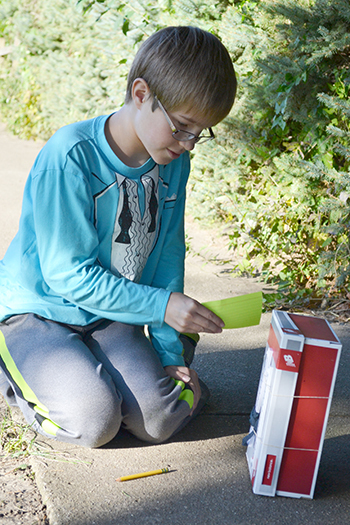
STEAM Studio student waves a piece of paper to cool down the wet-bulb thermometer in his sling psychrometer.
"It truly is their project,"asserts Nelson, "and they're loving it."
So what happens in the winter months, when there are not as many birds around? Nelson, who has actually done programming at a bird sanctuary, has a ready answer: "Zero is just as important as fifty, because that says something too."
The younger kids are working on pollination. This fall, Dr. Lesley Deem from Illinois' Pollinatarium taught them how to identify the bees; in the spring, the students will work with her to collect data, actually sitting by flowers to see how many types of bees show up, then drawing them.
Making Nelson's job easier is the proximity of a world-class university with a wealth of top scientists, who, according to Nelson, are eager to help. "So that's a key component; we're really trying to get scientists in to work with these students and explain why it's important."
Created by Nelson and Next Generation School Director Chris Bronowski, STEAM was born out of brainstorming sessions about offering a non-traditional STEM opportunity. The idea was to "make it into a type of studio opportunity for the students, give them an enrichment opportunity in the area, let them explore and bring their creativity and their ideas to it."

Nelson helps a STEAM student build his sling psychrometer.
And, according to Nelson, what STEAM emphasizes is partially student-driven. "I think that's what I love the most about this,"she admits, "if they say, ‘You know, we really are curious about how those tornado winds work,' then it's like, ‘Ok, fine, we're going to figure out how they work. That's what we're going to do. And the experiment might not work, but that's something that happens to real scientists, so let's talk about why that didn't work. Why didn't we get a tornado when we did that?' So it's really allowing them to be scientists and to use their creativity to find solutions to these problems."
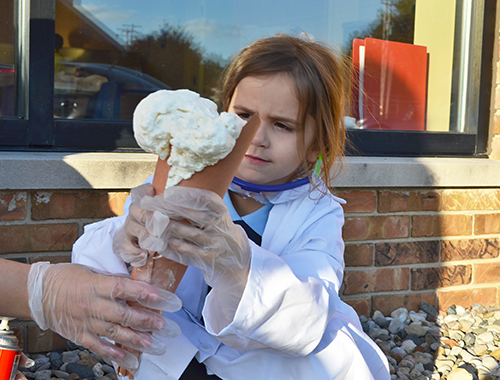
A STEAM student makes a flowstone speleothem for their cave using spray insulating foam. Once it dries, she will paint it, then place it in the cave they're making.
A perfect fit for the program, Nelson has degrees in science and teaching of science and math, with a focus on inquiry-based learning, as well as experience at Duke School, which emphasizes project-based learning, and has created programming at a bird sanctuary and science center. "So I had pieces of this all come together to be able to make this program into what it is,"says Nelson. "I've been through it all."
A proponent of inquiry-based learning, Nelson hopes to teach her students more than just some facts.
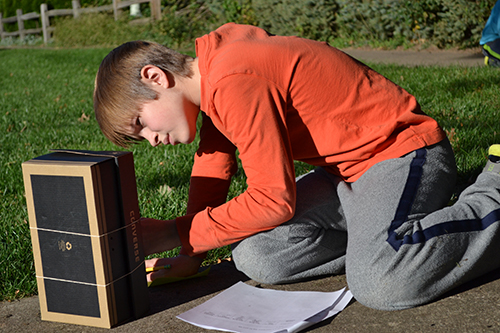
A student takes a reading on one of the thermometers on his sling psychrometer.
"There's no wrong or right answer; there are multiple answers to any problem. And if it doesn't work, ask a new question." She also wants them to realize that all learning doesn't come from a book.
"You use that knowledge and you need that knowledge but it's how you apply it and how you play with it that you find the new information."
She also hopes the students discover that individual strengths are multiplied through synergy, so that later in life, collaboration just comes naturally.
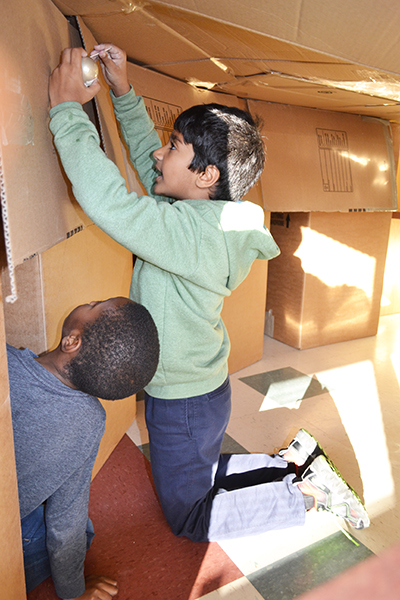
Two Zeptos STEAM Studio participants use clay to attach "cave pearls" to the cave they're building.
"Everyone is bringing a different skill and a different idea, and the only way that we're going to be able to solve the 21st Century problems that are out there is to be having different skills in different ways… So it's great to see them have those opportunities and all bring something different to the table, and feel like that's ok to be different and have different ideas."
Nelson shares an anecdote as proof of STEAM Studio's impact: "It's fantastic to see them come in so excited, that their first intention is not to go and play with toys, but they want to get to their studio activity." Then she refers to a recent activity where students had to melt chocolate as fast as possible to give Hershey's a new type of drink. "They want to come back, and they want their chocolate, not to eat, but to experiment with." Now that's quite an impact.
"These kids are so fortunate,"she adds. "I feel like this is one of those opportunities that will make such a difference for them."
Story and photos by Elizabeth Innes, Communications Specialist, I-STEM Education Initiative.
More: K-6 Outreach, Next Generation School, STEAM Studio, 2014
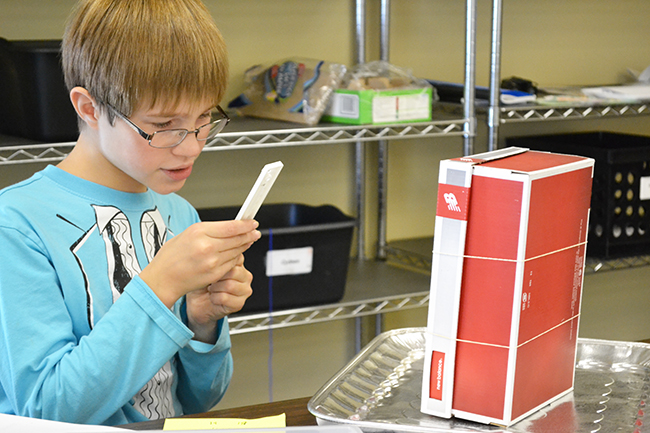
A Terra Group STEAM student uses his sling psychrometer to measure the relative humidity of their classroom.
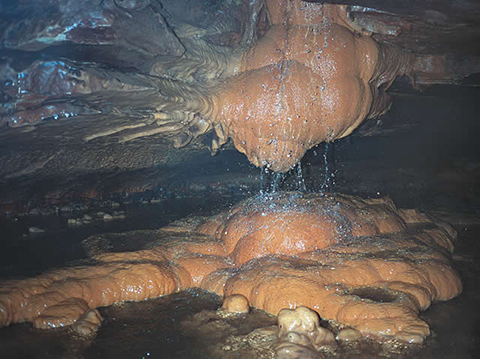













.jpg)
















